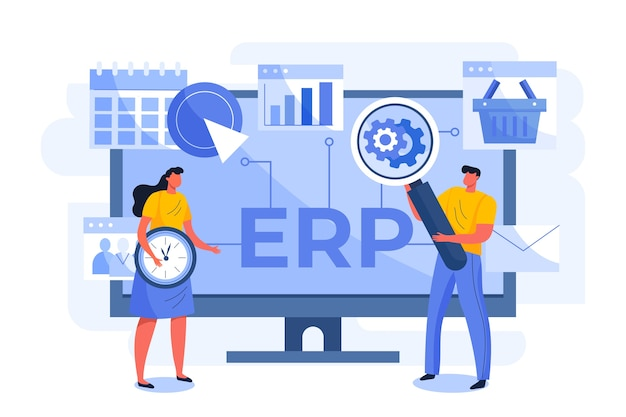Operational efficiency differentiates thriving businesses from those merely surviving in today’s competitive landscape. The benefits of Sage Intacct and Sage 300 are often the primary reasons behind this efficiency.
For any business, leveraging the right Enterprise Resource Planning (ERP) solutions is a strategic move to enhance productivity, accuracy, and decision-making. Let’s look into the benefits of Sage Intacct and Sage 300, understand their functionalities, implementation, and how they can transform your business operations.
Plus, while we’re at it, don’t forget to explore tips from our expert Sage consultants about maximizing the features of Sage ERPs.
Understanding ERP and Its Importance
ERP systems integrate various business processes into a single, unified system. They are essential for managing day-to-day operations, from financial management and inventory control to reporting and compliance.
For businesses in Canada, adopting an ERP solution like Sage Intacct or Sage 300 can provide a competitive edge, helping to streamline workflows and improve overall efficiency.
Sage Intacct and Sage 300 are two powerful ERP solutions designed to meet the diverse needs of businesses.
The cloud-based solution, Sage Intacct, is known for its advanced financial management capabilities, suited for small to medium-sized enterprises looking for scalability and flexibility.
Conversely, Sage 300 (formerly known as Sage Accpac) is a comprehensive ERP system that offers robust functionality for financial management, inventory control, and more, making it ideal for larger enterprises or those with more complex operational needs.
Key Features of Sage Intacct
Sage Intacct offers a wide range of features designed to streamline financial management and other critical business operations. Some of the standout features include:
- Advanced Financial Management
Sage Intacct excels in financial management, providing comprehensive tools for accounts payable, accounts receivable, cash management, and general ledger. Its multidimensional reporting capabilities allow for detailed financial analysis, helping businesses make informed decisions.
- Cloud-Based Accessibility
Being a cloud-based solution, Sage Intacct offers accessibility from anywhere, at any time. This is particularly beneficial for businesses with remote teams or multiple locations. The cloud infrastructure also ensures automatic updates and robust security measures.
- Automation and Efficiency
Automation is at the core of Sage Intacct’s design. It automates routine tasks such as data entry, invoicing, and reconciliation, reducing the chances of errors and freeing up valuable time for employees to focus on strategic activities.
- Integration Capabilities
Sage Intacct seamlessly integrates with various other software solutions, including CRM systems, payroll services, and other ERP modules. This ensures a cohesive and streamlined workflow across different business functions.
Key Features of Sage 300
Sage 300 is a versatile ERP solution with a rich set of features catering to more extensive and complex business requirements. Key features include:
- Comprehensive Financial Management
Like Sage Intacct, Sage 300 offers robust financial management tools. It includes modules for general ledger, accounts payable, accounts receivable, and financial reporting, providing a complete view of the company’s financial health.
- Inventory and Order Management

Sage 300 excels in inventory and order management, making it ideal for businesses with substantial inventory needs. It offers real-time inventory tracking, order processing, and warehouse management, ensuring optimal stock levels and efficient order fulfillment.
- Multicurrency and Multilingual Support
For Canadian businesses operating internationally, Sage 300 provides multicurrency and multilingual support. This feature facilitates seamless transactions and communication with global partners and customers.
- Customizability and Scalability
Sage 300 is highly customizable and scalable, allowing businesses to tailor the system to their specific needs and grow with the solution over time. This flexibility ensures that the ERP system remains relevant and efficient as the business evolves.
Benefits of Sage Intacct and Sage 300
Implementing Sage Intacct and Sage 300 offers numerous benefits that can significantly enhance business operations. Here are some of the key advantages:
1. Improved Accuracy and Reduced Errors
One of the primary benefits of Sage Intacct and Sage 300 is improved accuracy in financial reporting and inventory management. Automation reduces manual data entry, minimizing the risk of errors and ensuring more reliable data.
2. Enhanced Productivity
By automating routine tasks, both Sage Intacct and Sage 300 free up employees’ time, allowing them to focus on higher-value activities. This boost in productivity can lead to increased efficiency and profitability.
3. Better Decision-Making
With advanced reporting and analytics capabilities, these ERP solutions provide valuable insights into business performance. Access to real-time data helps decision-makers make informed choices, driving strategic growth.
4. Streamlined Operations
The integration capabilities of Sage Intacct and Sage 300 ensure a seamless flow of information across different departments. This streamlining of operations reduces bottlenecks and improves overall efficiency.
5. Scalability
Both ERP solutions are scalable, making them suitable for businesses of all sizes. As your business grows, Sage Intacct and Sage 300 can adapt to your evolving needs, providing a sustainable solution for the long term.
6. Compliance and Security
Sage Intacct and Sage 300 come with robust compliance and security features. They help businesses adhere to regulatory requirements and protect sensitive data, ensuring peace of mind and operational continuity.
Choosing the Right ERP Solution for Your Business

Selecting the right ERP solution is crucial for maximizing the benefits of Sage Intacct and Sage 300. Here are some factors to consider when making your decision:
1. Business Size and Complexity
While the benefits of Sage Intacct and Sage 300 are applicable to a wide range of businesses, both have a few limitations. This is why Sage Intacct is ideal for small to medium-sized businesses looking for a flexible, cloud-based solution. In contrast, Sage 300 is better suited for medium and larger enterprises with more complex needs with on-premises solution.
2. Industry Requirements
Consider the specific requirements of your industry. For instance, businesses with significant inventory management needs may benefit more from Sage 300, while those focusing on advanced financial management may find Sage Intacct more advantageous.
3. Budget and Resources
Assess your budget and available resources for ERP implementation and maintenance. While both solutions offer excellent value, the total cost of ownership, including implementation and ongoing support, should align with your financial capabilities.
4. Customization Needs
Determine the level of customization required. If your business has unique processes that need tailored solutions, Sage 300 high customizability might be the better option. Sage Intacct also offers customization but within the framework of its cloud-based environment.
5. Future Growth Plans
Consider your long-term growth plans. Both Sage Intacct and Sage 300 are scalable, but your future business goals may influence which solution offers the best fit for sustainable growth.
Implementation Process of Sage ERP Solutions
Implementing an ERP solution is a significant undertaking that requires careful planning and execution. Here are the steps involved in implementing Sage Intacct and Sage 300:
1. Assess Your Needs
Begin with a thorough needs assessment to identify the specific requirements of your business. This involves evaluating current processes, identifying pain points, and setting clear objectives for the ERP implementation.
2. Selecting the Right Partner
Choosing the right implementation partner is crucial for success. A Sage consultant, like Microsys, can provide expert guidance and support throughout the implementation process. Our experience and knowledge can help tailor the solution to your business needs.
3. Planning and Preparation
Develop a detailed implementation plan that outlines the timeline, resources, and responsibilities. This phase includes data migration planning, system configuration, and setting up necessary infrastructure.
4. Customization and Integration
Customize the ERP solution to fit your business processes. This may involve configuring modules, setting up workflows, and integrating with other systems. Ensure seamless data flow and process alignment across departments.
5. Training and Change Management
Training your team is critical for a successful ERP implementation. Provide comprehensive training sessions to ensure users are comfortable with the new system. Additionally, implement change management strategies to address any resistance and ensure smooth adoption.
6. Testing and Quality Assurance
Conduct thorough testing to identify and resolve any issues before going live. This includes functional testing, user acceptance testing, and performance testing to ensure the system meets all requirements.
7. Go-Live and Support
Once testing is complete and the system is ready, proceed with the go-live phase. Monitor the system closely during the initial period to address any issues promptly.

Ongoing support from your Sage consultant is essential to ensure the system continues to operate smoothly and meets evolving business needs.
9 Tips from Expert Sage Consultants for Maximizing ERP Solutions
Microsys’ Sage consultants, with their extensive experience and deep understanding of these systems, offer valuable insights to help businesses maximize the benefits of Sage Intacct and Sage 300.
Here are a few of those to ensure you get the most out of your ERP investment:
1. Conduct a Comprehensive Needs Analysis
Before implementing an ERP solution, it’s crucial to conduct a thorough needs analysis. This involves understanding your business processes, identifying pain points, and setting clear objectives for what you want to achieve with your ERP system.
The benefits of Sage Intacct and Sage 300 can only be fully realized when the system is aligned with your specific business needs. A detailed needs analysis helps in customizing the ERP to address your unique requirements effectively.
2. Invest in Proper Training
One of the most important steps to maximize the benefits of Sage Intacct and Sage 300 is investing in proper training for your staff.
Ensure that all users are well-trained on how to use the system efficiently to significantly enhance productivity and reduce errors. Sage consultants recommend ongoing training sessions to keep users updated on new features and best practices.
3. Leverage Automation Features
Both Sage Intacct and Sage 300 offer robust automation capabilities. To maximize the benefits of these ERP solutions, identify repetitive tasks that can be automated.
Automation not only reduces manual errors but also frees up time for employees to focus on more strategic activities. Sage consultants can help you identify areas where automation will have the most significant impact.
4. Customize Reports for Better Insights
Customizing reports is essential to gain better insights into your business operations. Sage Intacct and Sage 300 offer powerful reporting tools that can be tailored to provide the specific data you need.
Sage consultants suggest working closely with your implementation partner to create customized reports that deliver actionable insights, and support informed decision-making.
5. Regularly Review and Optimize Processes
Continuous improvement is key to maximizing the benefits of Sage Intacct and Sage 300. Regularly review your business processes to identify areas for optimization.
Sage consultants recommend conducting periodic audits of your ERP system to ensure it remains aligned with your business objectives and adapts to any changes in your operational needs.
6. Utilize Integration Capabilities
To fully capitalize on the benefits of Sage Intacct and Sage 300, leverage their integration capabilities. Integrating your ERP system with other business applications, such as CRM, payroll, and e-commerce platforms, ensures a seamless flow of information across different departments.
This integration enhances efficiency and provides a more comprehensive view of your business operations.
7. Focus on Data Management and Cleanliness
Effective data management is critical for the success of any ERP system. Sage consultants emphasize the importance of maintaining clean, accurate, and up-to-date data within your ERP system.
Implement data governance policies and regularly audit your data to avoid discrepancies that can lead to inaccurate reporting and poor decision-making.

8. Foster Cross-Department Collaboration
Encourage cross-department collaboration to fully leverage the benefits of Sage Intacct and Sage 300.
When different departments work together within a unified ERP system, it leads to better communication, more cohesive workflows, and a more comprehensive understanding of business operations.
Sage consultants suggest regular interdepartmental meetings to discuss ERP usage and identify areas for collaboration and improvement.
9. Engage with Expert Support
Ongoing support from Sage consultants is invaluable in maximizing the benefits of Sage Intacct and Sage 300. Engaging with experts who can provide guidance, troubleshoot issues, and offer strategic advice ensures your ERP system continues to meet your business needs effectively.
Regular check-ins with your Sage consultant can help you stay ahead of potential challenges and capitalize on new opportunities.

Get Started with Microsys
Microsys has established itself as a leading provider of Sage ERP solutions in Canada. With extensive experience in deploying Sage Intacct and Sage 300, we have helped numerous businesses streamline their operations and achieve strategic goals.
Are you ready to maximize the benefits of Sage Intacct and Sage 300 for your business? Partner with Microsys for expert guidance and support throughout your ERP implementation journey. Our team of Sage consultants in Toronto, Markham, Stouffville, Richmond Hill, Ajax, Ottawa, North York, Newmarket, and Aurora is dedicated to helping you achieve operational excellence and drive growth.
Contact us today to schedule a consultation and learn how our Sage ERP solutions can transform your business operations. Let us help you streamline processes, improve efficiency, and position your business for long-term success!



